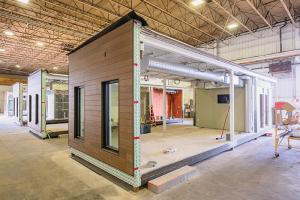A hospital owner's project requirements

The OPR process establishes the foundation for a win-win situation for all involved parties, including patients and families, staff, hospital leaders and the design team.
Image by Getty Images
An owner's project requirements (OPR) document continues to be a somewhat obscure term today. Apart from capital project teams at large, well-funded institutions or facilities owners very familiar with project commissioning, the term is usually unfamiliar to project teams.
However, when properly executed during the project planning phase, the development of an OPR can become one of the most critical steps in overall project execution.
According to ASHRAE, an OPR details the functional requirements of a project and the expectations of how it will be used. It includes project and design goals, measurable performance criteria and other critical information.
Stakeholder involvement
The greatest value realized through the OPR process is that all involved parties engage in defining the project requirements, thus addressing all stakeholder needs. Listening to the concerns and hopes from a variety of stakeholders and including a few of their recommendations in the design will make for a more successful project and overall efficient operation.
Stakeholders like patients, visitors and staff will think of things that even the most seasoned designers may not. An OPR document optimizes project delivery for all involved parties. When the project team works together and commits to following the OPR guidelines, it results in a reduction of change orders and rework, therefore reducing overall costs. This commitment will help the project team align around the fulfillment of project goals, requirements and ultimate success.
A successful OPR process should always lead to meaningful cost savings on a construction project. The scale of those savings depends upon the size and scope of the project, as well as commitment from the project team. For a small, $1 million project, the savings could be less than $20,000 to $25,000. However, for a large project in the hundreds of millions, the savings easily could exceed $1 million. The OPR informs the design and construction teams, from the programming phase through final occupancy and operational readiness of the facility, on behalf of all the potential end users.
An experienced owner’s representative, owner’s project manager or commissioning firm should be qualified to perform this service. Any of these qualified individuals should become part of the owner’s team — not operating as a separate entity but as part of the core team whose sole mission is to achieve all the owner/client goals and ensure things are done correctly.
Occasionally, an owner chooses not to include commissioning in their project. This is a recipe for disaster because commissioning should be included in every major capital project. However, the OPR process should be completed regardless. Moreover, its focus should go far beyond mechanical, electrical and plumbing outcomes because they are only one component of a comprehensive OPR document.
Customer and employee engagement
All projects are initially conceived as an improvement upon the current state or as a new service altogether. If not solving a problem, improving quality, creating efficiencies or growing revenue, why invest the time or money? With that in mind, who are the true customers — the people the project team needs to satisfy?
Consider the environmental monitoring requirements in an operating room suite. Everyone understands the requirements for temperature, humidity, pressure differentials and air-particle monitoring. However, has the design team asked the plant operators what might make their jobs easier?
These team members have tremendous responsibility. If they cannot properly maintain systems and infrastructure, the revenue-producing operations are at risk. Hearing the concerns and recommendations of these critical employees will reduce the opportunity for mistakes, ensure consistency, improve reliability, make for easier training and comprehension, and reduce operating costs. No one understands their systems better than they do.
Members of a supply chain team deliver materials to inpatient units. Food services staff deliver food to patients. Environmental services (EVS) staff clean patient rooms and nearly every other space. Facilities management staff ensure reliable operations of equipment and utilities, which requires access to patient areas to perform important maintenance activities.
Complex information technology (IT) infrastructure is critical to the successful operation of all new facilities; therefore, IT team members also should be invited to participate. Each of these operations teams should be given a voice during the planning process alongside the leadership and clinical teams. They know better than anyone the greatest challenges in providing a high level of service in the safest, most efficient manner.
Have EVS and food services workers been asked what their greatest challenges are? What makes doing their jobs difficult? What works well? What doesn’t work well? What would they most like to see in a new inpatient unit, conference space or lab? Only after these questions are answered can a design team fully achieve the goals and vision of their client. While the answers may seem obvious to people working in health care facilities, it is rare that a designer has spent any amount of time in the types of spaces they’re designing.
The goal for any project should be to ensure customer expectations are met at the very least and exceeded whenever possible. Including a representative group of those end users in the planning and design process beginning with the OPR can ensure success.
Taking this philosophy a step further and including these people in critical planning meetings with key members of the project team speaks volumes about an organization’s commitment to their employees. Those employees will feel a sense of ownership and pride, which often becomes one of the best forms of marketing any organization can hope for.
Establishing expectations
It’s nearly impossible to fulfill the requests and demands of everyone involved. Some requests are unrealistic or beyond the defined scope, while other requests may lack logic altogether. With that said, simply including all affected parties in the OPR process allows all stakeholders to share their ideas and feel heard — this is a win by itself.
It also presents the appropriate leaders with opportunities to either respond in the moment or follow up later. Following through and communicating with participants drives engagement in a meaningful way. Even when a strategic capital project takes years to complete, those participants will feel a sense of pride and ownership in the finished product if their leaders communicate proactively and transparently.
It is imperative that senior-level leaders involved in the process take the opportunity to explain that not all requests will be incorporated into the design and construction. However, it’s important to explain why. At some point during the OPR process, it must be determined whether the project concept and goals can be achieved within the established constraints: budget, timeline/schedule, and meeting patient and end-user requirements. Transparency during this process is essential.
Usually, project designers have their own vision for what a completed project should look like. Some wish to leave their personal touch, leading customers down a path that may not be practical or preferred. Others may hope their design will be recognized or win awards. It’s important for the client/owner to be explicitly clear about their expectations because the architect and engineer work for the owner.
For example, during project planning for a nearly $200 million project a few years ago, a hospital facilities director expressed the desire to minimize the number of different light fixtures included in the design. It was a practical request based upon decades of collective experience. Stocking light fixtures and their corresponding components for maintenance purposes requires space and significantly drives up storage and operating costs, while standardization significantly reduces operating costs.
During review of the initial design, the team noticed the plans included more than 30 different light fixtures, which was a direct contradiction of their request explicitly stated in the OPR document. While the architect was not happy about the denial of this design component, it was an easy conversation, as it required a simple reminder about who worked for whom and the expectations stated explicitly in the OPR document. In this case, both teams ended up compromising by agreeing to cut the different types of fixtures in half, allowing plenty of design appeal while also improving standardization and overall operating costs.
The OPR process establishes the foundation for a win-win situation for all involved parties. Patients and families, staff, hospital leaders and the design team are all given the opportunity to share their opinions and ask questions. However, upon final OPR document completion, everyone should have a clear understanding of expectations.
Once completed, the OPR should not be changed due to the personal preferences or opinions of any one individual or group.
Comprehensive design
Many utilities systems were traditionally designed with individual components that require routine maintenance. Consider heating, ventilating and air-conditioning (HVAC) components such as variable air volume (VAV) boxes, which are often only accessible from within hospital inpatient rooms. During the OPR process, an HVAC technician might ask, “Is there any way the VAV boxes can be located outside the patient rooms so we do not have to disturb a patient when maintenance is required?" or "Could you also make sure the VAVs can be easily accessed so the maintenance technicians don’t have to contort themselves around pipes and over ductwork to reach the equipment that most commonly requires maintenance?”
While solving some of these problems may be complex, the answers are generally more straightforward and should always be included in an OPR document. In this type of situation, the design engineer should ensure that all VAV boxes are located outside patient rooms and also are easily accessible. Years down the road, the maintenance technician who made the initial request, along with his or her peers, will remember that they were invited to participate and that their voices were heard during the planning phase of the project because each time one of them has to repair or replace a VAV box, they’ll be able to do so without disturbing a patient and without putting themselves at risk.
The key takeaway is that only when the entire team is consulted and given a voice through the OPR process will the designer avoid missing subtle yet critical details in the design.
Financial impact
In today’s tumultuous society, employee engagement and retention should be a top priority for every organization. Including end users in the OPR process goes a long way to engaging members of the team, regardless of their position within the organization. For large organizations, improving engagement and reducing turnover can save millions of dollars each year. Employee turnover costs organizations thousands of dollars per employee.
The Advisory Board, a well-respected health care consulting group, reported that health system employee turnover rose to 18.8% in 2021. Because health care organizations are among the largest employers in most regions, consider the financial implications of this figure. If an organization with 20,000 employees turns over 18.8% of their employees in a year, that equates to 3,760 lost employees. If each of those employees is replaced and the organization is fortunate enough to spend only $15,000 on each new hire, it would cost the employer more than $56 million. (The actual cost is far greater due to the conservative numbers used in this example.) How many organizations can afford to lose $56 million in a year?
That same employer who loses 3,760 employees and spends $56 million to replace them could invest a small fraction of that money in leadership development, employee training and development, and employee engagement. Think about how many executive coaches, even consultants providing those services, that employer could hire for a mere 5% or 10% of that amount. Five million dollars goes a long way toward developing and implementing programs that lead to improved engagement, minimizing turnover and impacting the bottom line in a meaningful and tangible way.
Facilities managers may find themselves asking what this has to do with the OPR process. Including a broad and diverse group of employees in the OPR process — representation from all impacted departments — can improve employee engagement for those employees. Their positive experiences often create a domino effect, influencing their peers and colleagues, which reduces turnover and therefore costs.
Consider the impact of not completing an OPR during project planning. A project will almost certainly experience problems that are largely avoidable if addressed during planning — challenges that might have been avoided had there been a simple discussion addressing potential issues. Technology and workflows are constantly evolving. In a traditional lab, work surfaces and equipment are usually fixed in place, meaning they cannot be moved without creating greater impact to the surrounding environment.
However, the OPR process might determine that if lab employees could adjust their work surfaces, their processes could be completed more safely and more efficiently. Over time, these types of inefficiencies lead to a loss in productivity, delayed outcomes and damage to employee engagement. Once inefficient work processes are understood, solutions can be developed to eliminate the problem altogether.
An important tool
The OPR exercise is one of the most important tools available to align all stakeholders on construction needs and requirements. It ensures quality project delivery while minimizing costly changes later in the process. However, it unfortunately tends to be the first service eliminated from a project scope during the value engineering process.
This is a mistake. Investing in the OPR process during the project planning phase may cost more up front, but it will lead to cost avoidance throughout the duration of the project and reduce the total cost of operating the facility throughout the life of the asset.
Without it, there is a risk of never achieving the team dynamic so critical to construction projects today. OPRs will reduce or prevent compounding expenses in rework, changes and/or retrofits that end up being exponentially higher than the cost of including OPR in the scope to begin with.
Facilities managers should invest in this process up front to avoid unnecessary headaches and higher costs throughout the project.
Wallace Pooler, CHFM, CHC, is chief operations officer at National Firestopping Solutions in Saco, Maine. He can be reached at wpooler@nefirestop.com.




